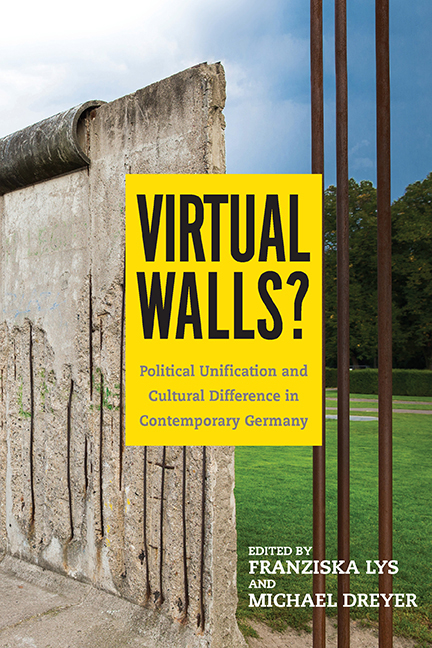Book contents
- Frontmatter
- Dedication
- Contents
- Acknowledgments
- Introduction: United Politics—Divided Culture?
- Part I What Remains: History and the Constitution
- Part II What and How Do We Remember? Literature, Film, and Exhibitions
- 3 East German Literature and Reunification: Continuities and Discontinuities
- 4 The Afterlife of the GDR in Post-Wall German Cinema
- 5 Exhibiting 1989/2009: Memory, Affect, and the Politics of History
- Part III A Changing Reception: Painting, Orchestras, and Theaters
- Part IV A Virtual Wall? Education and Society
- Epilogue: The Wende and the End of “the German Problem”
- Notes on the Contributors
- Index
3 - East German Literature and Reunification: Continuities and Discontinuities
from Part II - What and How Do We Remember? Literature, Film, and Exhibitions
Published online by Cambridge University Press: 24 August 2019
- Frontmatter
- Dedication
- Contents
- Acknowledgments
- Introduction: United Politics—Divided Culture?
- Part I What Remains: History and the Constitution
- Part II What and How Do We Remember? Literature, Film, and Exhibitions
- 3 East German Literature and Reunification: Continuities and Discontinuities
- 4 The Afterlife of the GDR in Post-Wall German Cinema
- 5 Exhibiting 1989/2009: Memory, Affect, and the Politics of History
- Part III A Changing Reception: Painting, Orchestras, and Theaters
- Part IV A Virtual Wall? Education and Society
- Epilogue: The Wende and the End of “the German Problem”
- Notes on the Contributors
- Index
Summary
What Is “East German Literature,”and Who Are “East German Authors”?
THE TITLE CONTAINS A KEY TERM that may need clarification: “East German literature.” This was already a relatively problematic term prior to 1989, since it was so difficult to define. Did “East German literature,” for instance, include the literature of former GDR citizens who went to the west, such as Uwe Johnson, Günter Kunert, Sarah Kirsch, or Wolf Biermann? And even when it was written by citizens of the GDR who remained in the GDR, to what extent could one speak of “East German literature” as something separated from that larger sphere of literary activity known as “German literature?” These were not easy questions to answer even before 1989. Now, almost three decades later, they have become doubly complicated, since the GDR no longer exists as a state. A writer like Thomas Brussig (born in 1965), who has had a major impact on the literary picture of East Germany since reunification, does not even want to be called an East German writer. He would like to think of himself primarily as a German writer.
No doubt for Brussig part of the reluctance to be seen as an “East German” writer comes from resistance to the GDR literary establishment's attempt to create a canon of “DDR-Literatur,” as exemplified most prominently in the eleventh volume of the history of German literature put out by the Marxist think tank Institut für Gesellschaftswissenschaften beim ZK der SED (Institute for Social Sciences of the Central Committee of the SED) in 1976. In that volume Horst Haase designated GDR literature as “sozialistische Nationalliteratur der Deutschen Demokratischen Republik,” arguing that this literature was “fest gegründet auf das Leben und Wirken der werktätigen Menschen in der sozialistischen Deutschen Demokratischen Republik und auf die Existenz des internationalen Sozialismus/Kommunismus” and that it existed in energetic opposition to the purported imperialism of the Federal Republic of Germany and other capitalist states (Haase et al. 1976, 21, 28). Writers like Christa Wolf, whom Brussig sees as having supported the East German state in a conformist way, may have found entry into this volume as part of the East German canon, but Brussig would hardly like to see himself in such company.
- Type
- Chapter
- Information
- Virtual Walls?Political Unification and Cultural Difference in Contemporary Germany, pp. 59 - 71Publisher: Boydell & BrewerPrint publication year: 2017

